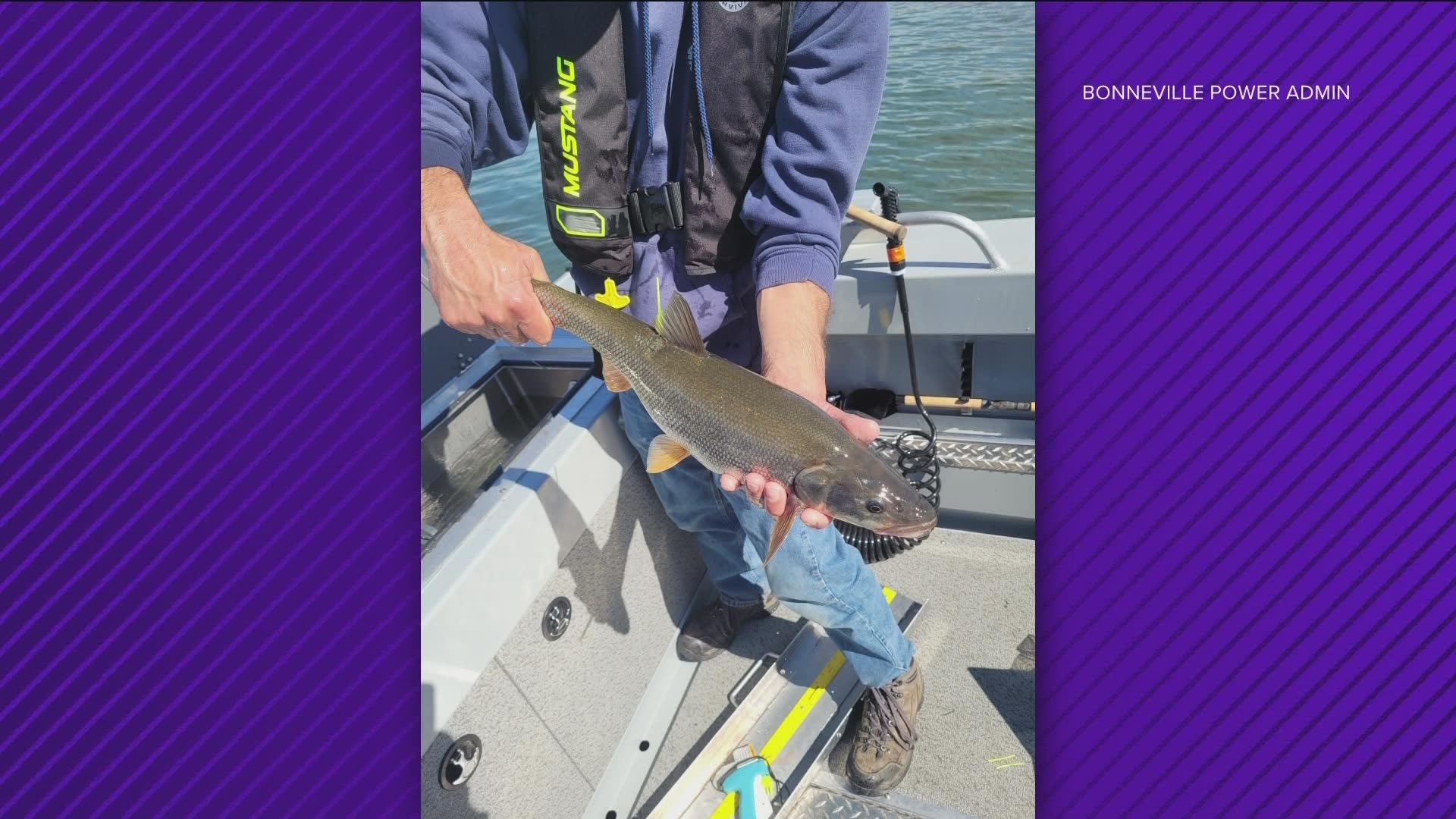IDAHO, USA — KTVB aired a segment on Monday, Dec. 19 about the 2022 Northern Pikeminnow Sport-Reward Program. The program, administered by the Pacific States Marine Fisheries Commission and Bonneville Power Administration, pays anglers to catch Northern Pikeminnows, a natural predator of the salmon that also live in the Columbia and Snake Rivers.
The project has been around since 1990, and since that time nearly 5.3 million Northern Pikeminnow have been removed from the Colombia and Snake Rivers. That's a lot of fish and something that Eric Winther, a biologist for Washington Department of Fish and Wildlife, is proud of.
"The cool thing is that we know removing those pikeminnows has a positive effect on the salmon population," Winther said. "It doesn't stop the other problems and not one single silver bullet will. But I know we have made a difference and that's pretty cool."
Those who aren't familiar with fishing, or the ecosystem of the rivers, may be wondering why there are so many Northern Pikeminnows in those rivers and why they are a problem.
The story starts with the dams and the subsequent issues those dams caused for salmon. Damming rivers creates power that communities rely on, can help with flood control and because the dams control the flow of the river it becomes possible to run barging traffic year-round, which is important to farmers transporting goods.
However, there are also downsides. Dams are getting older and can be costly to maintain. According to the U.S Army Corp of Engineers, in 2022, "the construction budget for modification to existing dams was approximately $363 million and budget for the routine dam safety program activities was over $50 million.
Idaho Congressman Mike Simpson has a salmon recovery plan, the Columbia Basin Initiative. It calls for restoring the river ecology, supporting communities, finding new types of energy and breaching the four lower Snake River dams.
Additionally, multiple Indigenous tribes and conservationists, like the local group Youth Salmon Protectors a part of the Idaho Conservation League, and Congressman Simpson have called for the breaching of the dams in the Columbia and Snake Rivers.
There have also been massive problems created by dams for the wildlife and Indigenous communities. Two species of Chinook Salmon are on the endangered species list and Coho Salmon are listed as being significantly threatened.
"People often point to predation and invasive species as the cause of salmon dissipation in the Snake and Columbia, and those are real threats," said Youth Salmon Protectors member Shiva Rajbhandari. "But study after study has shown that the biggest threat to Northwest anadromous fish is dams."
According to Stephen Pfeiffer, a Conservation Associate with Idaho Rivers United, prior to the damming of the Colombia and Snake Rivers, the Northern Pikeminnows and salmon evolved together in a fairly cohesive way. Both species of fish are native to the area.
"The environment the dams create are why the salmon have become so vulnerable," said Pfeiffer. "The pikeminnow predation is a symptom of the dams and based on the current science, the (Pikeminnow Sport-Reward) program is not addressing larger scale issues."
Northern Pikeminnows are a problem for salmon because they eat a lot of them. Pikeminnows prefer waters that are more stagnant, and these types of conditions are created in abundance by dams. According to Winther, they like to hide behind rocks and hunt the salmon that are coming through the dams during migration back and forth from the oceans. Further, pikeminnows are an incredibly long-living fish, over 11 years. Additionally, the dams make it harder for the salmon to migrate because it slows them down, which makes it easier for pikeminnows to eat them.
The Pikeminnow Sport-Reward Program helps with the problem. In 2022, anglers caught over 140,000 Northern Pikeminnows and according to Winther, that protects hundreds of thousands of young salmon and Steelhead Trout. Fishermen also get $6 to $10 a fish and collectively earned $1,367,398, funded by Bonneville Power Administration. According to the website, the administration is, "a self-funding, nonprofit federal power marketing administration within the Department of Energy."
The program also releases larger pikeminnows every year with tags. When asked why release fish that are part of the problem? Winther said they don't get all of those big fish back but, he said, that's ok because they aren't trying to totally decimate the pikeminnow and the amount released is small percentage. Some years they release more large pikeminnows than others, based on water conditions. It's done as an incentive to anglers and the tagged pikeminnows can fetch $200 to $500.
Winther said that he feels good about doing what he can to help the salmon population and that this program really helps, without monetary compensation many anglers wouldn't try to catch the bony fish. He said that he and the department do what they can while trying to navigate the environment the dams create.
Conservationists are still hoping that the dams can be breached, and the salmon are given back their natural habitat. Pfeiffer said that for the last 50 years, salmon have been on the endangered species list, and something needs to be done about it on a larger level.
"The lower Snake River dams are losing money and costing taxpayers billions," said Rajbhandari. "They are the primary cause of salmon decline in the Snake River Basin. While fisheries, predation control and other government programs can slow their decline, without breaching the four lower Snake River dams, wild salmon and Steelhead will go extinct, and with them the spirit of Idaho's rivers and communities."
When, or if, the dams will be breached, won't be decided anytime soon. Until then, the Pikeminnow Sport-Reward Program will keep being implemented in an attempt to lessen the impact on salmon.
Watch more Local News:
See the latest news from around the Treasure Valley and the Gem State in our YouTube playlist:

